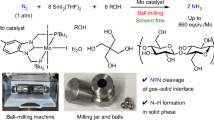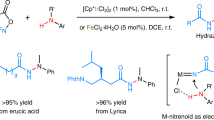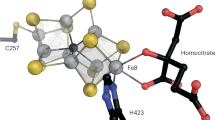Abstract
THE enzyme nitrogenase catalyses the reaction:  Nitrogenase is a metalloenzyme containing iron and molybdenum both of which are essential for catalytic activity. Reduction of nitrogen is thought to proceed in two-electron steps via bound intermediates at binuclear molybdenum and iron centres with the oxidation state of molybdenum changing possibly from 3+ to 6+ (refs. 1 and 2). Shilov et al.3 suggested that the 3+ oxidation state of molybdenum participated in the catalytic reduction of dinitrogen to hydrazine in an aqueous system at pH > 7 containing initially molybdate (VI), vanadium (II) or titanium (III), and magnesium (II). In view of this work and evidence4 that bound hydrazine is an intermediate in biological nitrogen fixation we have studied the reactions of hydrazine with binuclear molybdenum (III) and (V) in the compounds μ-dioxo-bis[triaquochloromolybdenum(III)], (I), and caesium μ-dioxo-bis[aquodichloro-oxomolybdenum(V)],(II)
Nitrogenase is a metalloenzyme containing iron and molybdenum both of which are essential for catalytic activity. Reduction of nitrogen is thought to proceed in two-electron steps via bound intermediates at binuclear molybdenum and iron centres with the oxidation state of molybdenum changing possibly from 3+ to 6+ (refs. 1 and 2). Shilov et al.3 suggested that the 3+ oxidation state of molybdenum participated in the catalytic reduction of dinitrogen to hydrazine in an aqueous system at pH > 7 containing initially molybdate (VI), vanadium (II) or titanium (III), and magnesium (II). In view of this work and evidence4 that bound hydrazine is an intermediate in biological nitrogen fixation we have studied the reactions of hydrazine with binuclear molybdenum (III) and (V) in the compounds μ-dioxo-bis[triaquochloromolybdenum(III)], (I), and caesium μ-dioxo-bis[aquodichloro-oxomolybdenum(V)],(II)
This is a preview of subscription content, access via your institution
Access options
Subscribe to this journal
Receive 51 print issues and online access
$199.00 per year
only $3.90 per issue
Buy this article
- Purchase on SpringerLink
- Instant access to full article PDF
Prices may be subject to local taxes which are calculated during checkout
Similar content being viewed by others
References
Hardy, R. W. F., Burns, R. C., and Parshall, G. W., Adv. Chem. Ser., 100, 219 (1971).
Williams, R. J. P., Inorg. Chim. Acta Rev., 3, 137 (1971).
Shilov, A., Denisov, N., Efimov, O., Shuvalov, N., Shuvalova, N., and Shilova, A., Nature, 231, 460 (1971).
Jackson, E. K., Parshall, G. W., and Hardy, R. W. F., J. Biol. Chem., 243, 4952 (1968).
Vogel, A. I., Quantitative Inorganic Analysis, second ed., 365 (Longmans, London, 1951).
Mitchell, P. C. H., and Scarle, R. D., J. Chem. Soc., Dalt., 1809 (1972).
Wing, R. M., and Callahan, P., Inorg. Chem., 8, 871 (1969).
Mitchell, P. C. H., Quart. Rev., 20, 103 (1966).
Mitchell, P. C. H., J. Inorg. Nuclear Chem., 26, 1967 (1964).
Bottomley, F., Quart. Rev., 24, 617 (1970).
Chatt, J., Proc. Roy. Soc., B, 172, 327 (1969).
Chatt, J., Dilworth, J. R., Richards, R. L., and Sanders, J. R., Nature, 224, 1201 (1969).
Browne, A. W., and Shetterly, F. F., J. Amer. Chem. Soc., 31, 783 (1909).
Huang, T., and Spence, J. T., J. Phys. Chem., 72, 4198 (1968).
Author information
Authors and Affiliations
Rights and permissions
About this article
Cite this article
MITCHELL, P., SCARLE, R. Role of Reactions of Molybdenum Compounds with Hydrazine in Nitrogen Fixation. Nature 240, 417–418 (1972). https://doi.org/10.1038/240417a0
Received:
Revised:
Issue date:
DOI: https://doi.org/10.1038/240417a0



